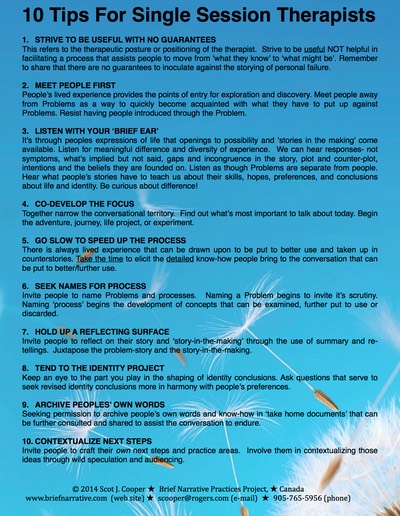Here are a few tips for the brief single session therapist. There are many aspects of the work and in no way is this list comprehensive. However my hope is that it will serve as a reminder of some key pieces for those new to the process. This list is informed by many exceptional theorists and practitioners who have been working in time constrained contexts and who have shaped the ‘ brief’ traditions of the work as well as my practice. Please see the list of influences below which is not extensive but highlights the roots and growth of the tradition.
- STRIVE TO BE USEFUL WITH NO GUARANTEES
s refers to the therapeutic posture or positioning of the therapist. Strive to be useful NOT helpful in facilitating a process that assists people to move from ‘what they know’ to ‘what might be’. Remember to share that there are no guarantees to inoculate against the storying of personal failure.
- MEET PEOPLE FIRST
People’s lived experience provides the points of entry for exploration and discovery. Meet people away from Problems as a way to quickly become acquainted with what they have to put up against Problems. Resist having people introduced through the Problem.
- LISTEN WITH YOUR ‘BRIEF EAR’
It’s through peoples expressions of life that openings to possibility and ‘stories in the making’ come available. Listen for meaningful difference and diversity of experience. We can hear responses- not symptoms, what’s implied but not said, gaps and incongruence in the story, plot and counter-plot, intentions and the beliefs they are founded on. Listen as though Problems are separate from people. Hear what people’s stories have to teach us about their skills, hopes, preferences, and conclusions about life and identity. Be curious about difference!
- CO-DEVELOP THE FOCUS
Together narrow the conversational territory. Find out what’s most important to talk about today. Begin the adventure, journey, life project, or experiment.
- GO SLOW TO SPEED UP THE PROCESS
There is always lived experience that can be drawn upon to be put to better use and taken up in counterstories. Take the time to elicit the detailed know-how people bring to the conversation that can be put to better/further use.
- SEEK NAMES FOR PROCESS
Invite people to name Problems and processes. Naming a Problem begins to invite it’s scrutiny. Naming ‘process’ begins the development of concepts that can be examined, further put to use or discarded.
- HOLD UP A REFLECTING SURFACE
Invite people to reflect on their story and ‘story-in-the-making’ through the use of summary and re-tellings. Juxtapose the problem-story and the story-in-the-making.
- TEND TO THE IDENTITY PROJECT
Keep an eye to the part you play in the shaping of identity conclusions. Ask questions that serve to seek revised identity conclusions more in harmony with people’s preferences.
- ARCHIVE PEOPLES’ OWN WORDS
Seeking permission to archive people’s own words and know-how in ‘take home documents’ that can be further consulted and shared to assist the conversation to endure.
- CONTEXTUALIZE NEXT STEPS
Invite people to craft their own next steps and practice areas. Involve them in contextualizing those ideas through wild speculation and audiencing.

